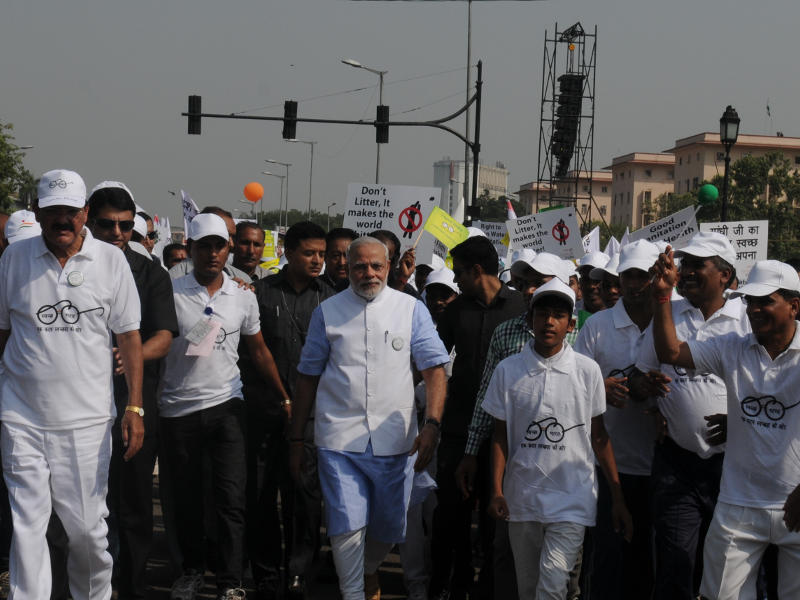- Home
- Internet
- Internet Opinion
- What PM Modi Should Do With the Swachh Bharat Tax
What PM Modi Should Do With the Swachh Bharat Tax

Chennai went through some of its darkest days last week, with most areas going without electricity and potable water due to floods. The Hindu stopped printing for the first time in 137 years, the Army was called in, and the death toll has been climbing. Could those problems have been avoided if there had been more private innovation, and more startups that tried to create machines that can solve the sewage problem, instead of launching smartphone after smartphone?
So far, we've seen the Delhi Government announce a 2 crore fund for startups to combat air pollution; we need to see this kind of behaviour scaled up, and brought across the country, to leverage not just the small cadre of civil servants and scientists, but the brains that have been diverted into the private sector.
Consider this; already articles have examined why Chennai resembled Venice in photos, and seemed to have merged with the sea. While the volume of rain may have been unprecedented, and there were plenty of other factors like unauthorised construction in low-lying areas, the floods also clearly indicate a failure of the city's stormwater drain system.
To cater to that kind of runoff, the natural drainage system has to be maintained. This seems to be an impossible situation considering demolishing houses is the least popular move that any politician can make. Many parts of the city lack a sewage system, relying instead, on septic tanks and pit toilets.
(Also see: Smart Cities Won't Work Without Smart Citizens)
"It's very difficult in coastal cities, if you have high tides, unprecedented rain, and unchecked developments," said S Vishwanath, founder of Rainwaterclub, Director of Biome Solutions in a phone conversation discussing why Chennai drowned. He agreed that one of the reasons why the stormwater drainage system failed was because it is also used for garbage disposal.
Coastal cities will have to brace themselves for more of such events in the future, considering abnormal weather events are likely to occur more frequently due to climate change.
Meanwhile, in Koramangala, Bengaluru's startup hub, it's common to see sewage water flowing out of manhole covers, slithering away for hundreds of metres. It's a problem that all of India's major cities are facing, with an antiquated drainage and sewage system straining to keep up with population growth and ineffective maintenance.
(Also see: It's Time to Go Green: Save the Planet and Money Too)
Sewage systems are old as civilisation itself, but our country seems to be really bad at making and maintaining them. If you think your job sucks, just log on to YouTube and see some of the videos of manual drain cleaners in India. There are plenty of indie documentary shorts on the subject.
Why aren't we making robots to do these jobs? Much as we cherish moonshot thinking, we need the best engineers and philanthropists to stare at our gutters, and come up with ways to eliminate one of the worst jobs in the world.
Take the example of this water wheel which operates in Baltimore, US, and imagine it cleaning up our rivers and storm drains. The government really needs to play an active role encouraging our universities to work on these problems, because venture capital surely won't. Maybe the government should announce an annual innovation prize with a huge sum of money like the Google Lunar X Prize, but for cleanliness and sanitation-related innovations.
This could be one of the best ways to use the new Swachh Bharat cess - everyone's paying and it's time we debated how these funds are going to be used. How would you like our government to use the Swacch Bharat Tax? Let's hear it in the comments below.
Catch the latest from the Consumer Electronics Show on Gadgets 360, at our CES 2026 hub.
Related Stories
- Samsung Galaxy Unpacked 2025
- ChatGPT
- Redmi Note 14 Pro+
- iPhone 16
- Apple Vision Pro
- Oneplus 12
- OnePlus Nord CE 3 Lite 5G
- iPhone 13
- Xiaomi 14 Pro
- Oppo Find N3
- Tecno Spark Go (2023)
- Realme V30
- Best Phones Under 25000
- Samsung Galaxy S24 Series
- Cryptocurrency
- iQoo 12
- Samsung Galaxy S24 Ultra
- Giottus
- Samsung Galaxy Z Flip 5
- Apple 'Scary Fast'
- Housefull 5
- GoPro Hero 12 Black Review
- Invincible Season 2
- JioGlass
- HD Ready TV
- Laptop Under 50000
- Smartwatch Under 10000
- Latest Mobile Phones
- Compare Phones
- Honor Win RT
- Honor Win
- Xiaomi 17 Ultra Leica Edition
- Xiaomi 17 Ultra
- Huawei Nova 15
- Huawei Nova 15 Pro
- Huawei Nova 15 Ultra
- OnePlus 15R
- Asus ProArt P16
- MacBook Pro 14-inch (M5, 2025)
- OPPO Pad Air 5
- Huawei MatePad 11.5 (2026)
- Xiaomi Watch 5
- Huawei Watch 10th Anniversary Edition
- Acerpure Nitro Z Series 100-inch QLED TV
- Samsung 43 Inch LED Ultra HD (4K) Smart TV (UA43UE81AFULXL)
- Asus ROG Ally
- Nintendo Switch Lite
- Haier 1.6 Ton 5 Star Inverter Split AC (HSU19G-MZAID5BN-INV)
- Haier 1.6 Ton 5 Star Inverter Split AC (HSU19G-MZAIM5BN-INV)

















